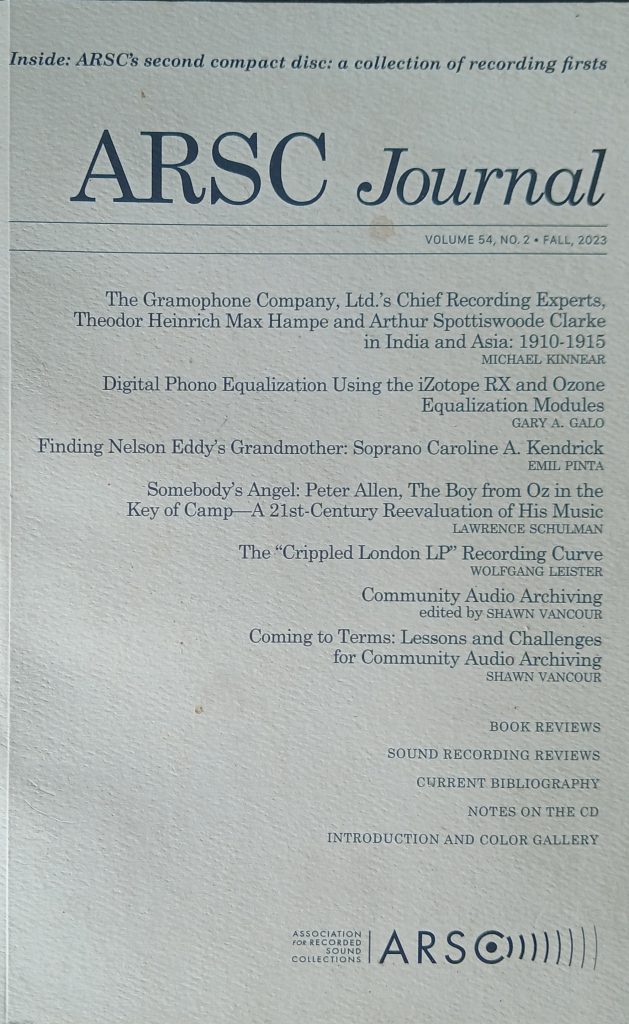 If truly obscure, truly early recordings are your pleasure you should subscribe to the Association for Recorded Sound Collections (ARSC) semi-annual journal. Though their exploration of sound reproduction is not caged by era or genre there are many exciting features about sound in the jazz era and before.
If truly obscure, truly early recordings are your pleasure you should subscribe to the Association for Recorded Sound Collections (ARSC) semi-annual journal. Though their exploration of sound reproduction is not caged by era or genre there are many exciting features about sound in the jazz era and before.
Recently they have taken to releasing an annual CD as well as two issues a year printed as soft cover books of over 200 pages. The first CD celebrated the new Federal recognition of a uniform public domain for sound recordings at 100 years. Overnight all recordings before 1923 entered the public domain. Prior to the Music Modernization Act, which the ARSC helped to pass, the lingering threat of unintentional infringement on even very obscure recordings from the 1880s had frightened them off from the practice of releasing sound recordings, something that would otherwise be very obvious for the organization to do.
I wrote about their special issue celebrating this milestone, and more on public domain history, in our May 2022 issue. Today I want to focus on their latest issue, dated Fall 2023. The second to contain a disc. Their second release is, as they joke, focused on “firsts,” be it the artist’s first recording, first recording of the title, or in some other way. For example, they include the first recording of what is now the Ukranian National Anthem (1910).
Instead of releasing an album of music entering the public domain since the last one, something I am sure someone is doing, they have again cast the net wide. Making for a diverse album starting with Sousa’s Band playing “King Cotton March” in 1895 and ending with Frank Ferera playing “Maui Girl” in 1922, in chronological order, with 16 of 23 recordings predating 1915. There are not many opportunities to hear music of this era, especially sourced and transferred so expertly and with scholarly notes of a few paragraphs to a page or two for each unique title.
The subjects vary from American rags and popular music to international offerings like Folk Songs Of The Pygmies, from 1905, the latter coming with an exceptionally interesting set of notes. Highlights that fall under the genres of this paper include Frank C. Stanley singing “Take Me Up With You, Dearie” from 1909, and Albert Benzler playing “Black and White Rag” on piano in 1911, a clear recording current players should study. The Versatile Four’s “Down Home Rag” from 1916 brings us to the cusp of jazz. A few other rags and English language recordings litter the CD.
Further afield you will hear a recording of a bar mitzvah speech given by a 13 year old boy in Turkey on January 3rd, 1914. Granted it is not particularly exciting without the context you will find in the notes, which includes the little to be known on a local record label. You will also hear klezmer music recorded in Warsaw in 1911, unique because most of the reference recordings for the style were recorded, as is true with many ethnic recordings of the period, in America. Another track was recorded in Tbilisi, Georgia in 1909, beautiful music played in a style from Azerbaijan.
For those with more knowledge and interest in classical music than I can claim, there are several tracks for you as well.
The CDs are truly worth the price of a subscription, but what else can you find in the ARSC Journal, and why should you become a member? While individual issues of the journal may be purchased for around $18 plus shipping a $45 annual membership gives you access to a PDF back catalog all the way back to 1966. It also lets you access recordings from the organization’s conferences and the bulletins between issues.
As an example of what you can expect the current issue includes articles titled “The Gramophone Company, Ltd.’s Chief Recording Experts, Theodor Heinrich Max Hampe, and Arthur Spottiswoode Clarke in India and Asia: 1910-1915,” “Community Audio Archiving: Coming to Terms: Lessons and Challenges for Community Audio Archiving,” and “The ‘Crippled London LP’ Recording Curve.” The journal also includes book and CD reviews relevant to sound preservation and the recording industry, and publishes a bibliography of articles of interest that have appeared in other publications since the previous issue, including many from The Syncopated Times. The book reviews section alerted me to a number of new titles we should review. As a resource there is nothing like the ARSC Journal.
As scholarly and impressive as this organization is many would assume that money for such a worthy endeavor flows effortlessly to them. As we know well at The Syncopated Times that is not the way of this modern world. Those with an interest in the history of sound recording owe it to themselves to join the ARSC and to read their publication, maybe even submit to it and get involved. $45 for two substantial issues, a CD of music you will never otherwise hear, and access to over 50 years of excellent research and writing is well worth it.
ARSC Journal
Volume 54, No. 2 Fall 2023, with Bonus CD
www.arsc-audio.org
Joe Bebco is the Associate Editor of The Syncopated Times and Webmaster of SyncopatedTimes.com





















